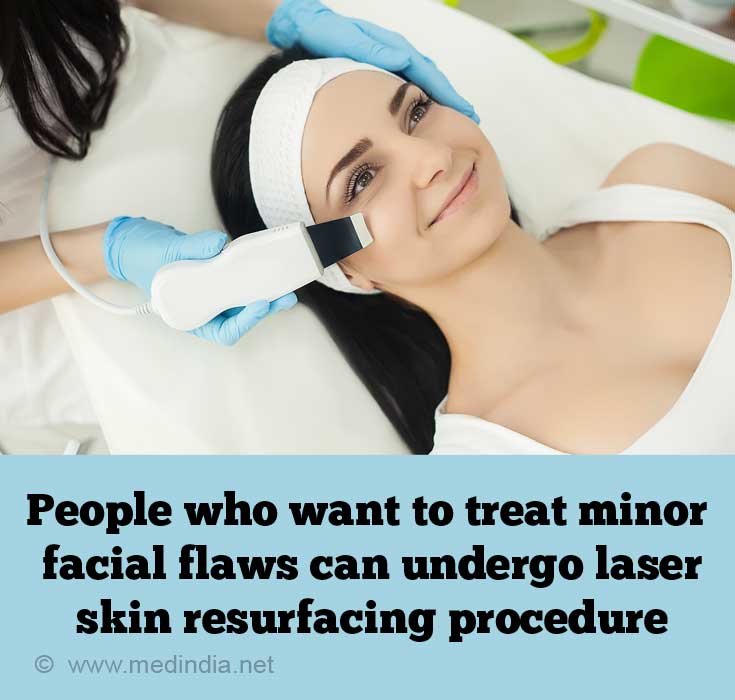- Laser Skin Resurfacing: Skin Care Procedure - American Society of Plastic Surgeons - (https://www.plasticsurgery.org/cosmetic-procedures/laser-skin-resurfacing)
- Laser Resurfacing - Mayo Clinic - (https://www.mayoclinic.org/tests-procedures/laser-resurfacing/about/pac-20385114 )
- Skin Resurfacing - American Academy of Facial Plastic and Reconstructive Surgery (AAFPRS) - (https://www.aafprs.org/patient/procedures/resurfacing.html)
- What is skin resurfacing? - (https://www.americanboardcosmeticsurgery.org/procedure-learning-center/non-surgical/skin-resurfacing-guide/)
What is Laser Skin Resurfacing?
Laser skin resurfacing, also known as laser peel or lasabrasion, is a high precision procedure that is used for improving skin texture and appearance. It uses a focused laser beam to remove the outer layer of skin, called the epidermis. It also heats the underlying layer of skin, called the dermis. This action stimulates the growth of new collagen fibers, so that during the healing process new skin cells are generated that make the skin firmer, smoother and younger looking.
The procedure is generally used for treating wrinkles, pigment spots, scars, and blemishes amongst others.
Types of Laser Skin Resurfacing & Types of Laser Used
Laser skin resurfacing is essentially two types: (i) Ablative and (ii) Non-ablative. The ablative procedure is so called because it involves removing layers of skin, while the non-ablative procedure does not require the removal of any skin layers.
The following types of lasers are used for laser skin resurfacing:
- Carbon Dioxide (CO2) Lasers: These are the earliest gas lasers to be developed. These were invented in 1963 by Dr. Chandra Kumar Patel, an electrical engineer, while he was at Bell Laboratories, USA. These are powerful infrared lasers based on a gas mixture in which light is amplified by CO2 molecules. These ablative lasers are used to treat deep skin flaws such as wrinkles, scars, and warts. Two leading manufacturers of CO2 lasers include LASERING USA, San Ramon, California, USA, and Asclepion Laser Technologies, Jena, Germany.
- Erbium Lasers: Erbium (symbol Er) is a chemical element used in erbium lasers. Erbium lasers are ablative lasers. The Erbium YAG laser is a solid-state laser having an active laser medium composed of erbium-doped yttrium aluminum garnet (Er: YAG). Erbium lasers are used for collagen remodeling of the skin, which is required for treating fine lines, wrinkles, skin laxity, and age spots. Two global leaders in manufacturing Er:YAG lasers are BLUECORE COMPANY Co., Ltd., Busan, Republic of Korea, and Laser Quantum, Cheshire, UK.
- Pulsed-Dye Lasers: These are non-ablative lasers, which use a concentrated beam of light, targeting the blood vessels of the skin. The light is converted into heat, destroying the blood vessel while leaving the surrounding skin intact. These lasers are used to treat facial redness, poikiloderma, spider veins, broken capillaries, port wine stain birthmarks, rosacea, stretch marks, scars, and cherry angioma. The VBeam pulsed-dye laser is the most advanced and is manufactured by Syneron Candela, San Francisco, California, USA.
- Fractional Lasers: These lasers are so called because the laser energy is broken-up into thousands of tiny beams that focus on a fraction of the affected skin surface. Fractional lasers can be ablative or non-ablative and are used to treat several types of age-related blemishes. Fraxel® is the original fractional skin resurfacing technology, manufactured by Solta Medical International Inc., Pleasanton, California, USA.
Who Should Undergo Laser Skin Resurfacing?
Individuals having the following conditions are good candidates for laser skin resurfacing:
- Fine lines and wrinkles
- Aged and sun-damaged skin
- Scars from acne or chickenpox
- Birthmarks e.g. linear epidermal nevi
- Enlarged oil glands on nose
- Warts
- Sagging skin
- Droopy eyelids
- Yellowish or grayish skin tones
- Crow's feet
- Liver spots







